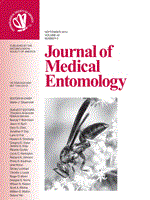West Nile virus (WNV) spread across most of North America within a short time period after its incursion into the Western Hemisphere. The Canadian prairies had the highest human incidence of WNV disease in Canada, particularly in 2007. Statistical modeling and geographic information systems can be used to develop a predictive model and facilitate the mobilization of targeted disease management strategies. Using data collected between 2005 and 2008, we constructed models integrating abiotic and biotic factors to predict the WNV infection rate in female Culex tarsalis Coquillett, the primary vector of WNV in the Canadian prairies. During the study period, the highest mean Cx. tarsalis infection rate was during week 34 (late August). The Cx. tarsalis infection rate increased with increasing Cx. tarsalis abundance and mean temperature lagged from 1 to 8 wk, but decreased with increasing mean precipitation lagged from 2 to 6 wk. Furthermore, precipitation was a ‘distorter variable’ that altered the association between Cx. tarsalis abundance and the WNV infection rate. Our model clarified how weather influenced the Cx. tarsalis infection rate in the Canadian prairies, a newly and highly WNV endemic region of North America. An understanding of the role of lagged weather variables was essential for providing sufficient lead time to predict WNV occurrence, and for implementing disease control and prevention strategies. Furthermore, it is a useful tool for assessing the potential effects of future climate change on WNV in areas near its northern distributional limit.
How to translate text using browser tools
1 September 2012
Predicting Weekly Variation of Culex tarsalis (Diptera: Culicidae) West Nile Virus Infection in a Newly Endemic Region, the Canadian Prairies
Chen-Chih Chen,
Tasha Epp,
Emily Jenkins,
Cheryl Waldner,
Philip S. Curry,
Catherine Soos
ACCESS THE FULL ARTICLE
It is not available for individual sale.
This article is only available to subscribers.
It is not available for individual sale.
It is not available for individual sale.

Journal of Medical Entomology
Vol. 49 • No. 5
September 2012
Vol. 49 • No. 5
September 2012
Canadian prairies
environmental variable
generalized linear mixed model
Geographic Information System
West Nile virus




